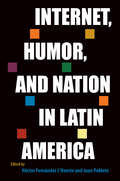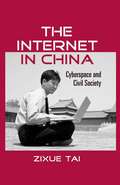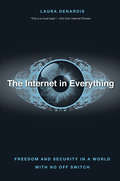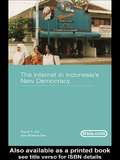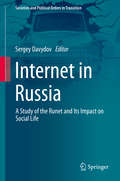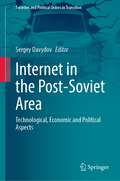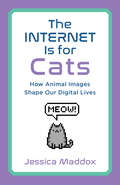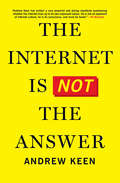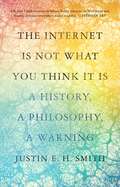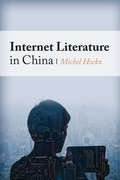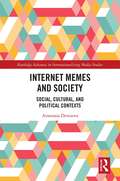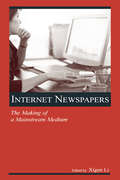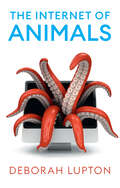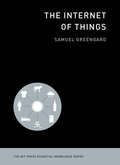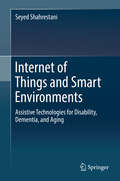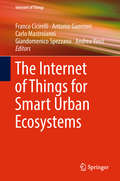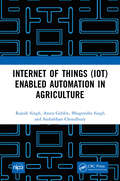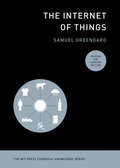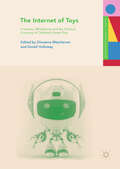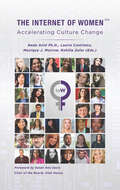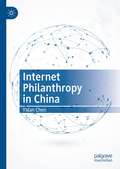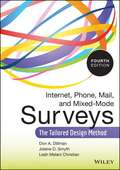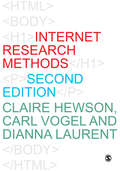- Table View
- List View
Internet, Humor, and Nation in Latin America (Reframing Media, Technology, and Culture in Latin/o America)
by Héctor Fernández L’Hoeste Juan PobleteHow online humor influences politics and culture in Latin America This volume is the first to provide a comprehensive Latin American perspective on the role of humor in the Spanish- and Portuguese-language internet, highlighting how the production and circulation of online humor influence the region’s relation to democracy and civil society and the production of meaning in everyday life. Several case studies consider memes, including discussions of political cartoons in Mexico and imagery that portrays the mismanagement of natural disasters in Puerto Rico. Essays on Brazil examine how memes are shared on WhatsApp by Jair Bolsonaro supporters and how the Instagram account Barbie Fascionista offers memes as political commentary. Other case studies consider video content, including the sketches of Argentinian comedian Guillermo Aquino, the short-form material of Chilean vlogger Germán Garmendia, and a satirical YouTube column created by journalists in Colombia. Contributors also offer new methodologies for studying the laughable on social media, including a model for analyzing fake Twitter accounts. Internet, Humor, and Nation in Latin America demonstrates that internet humor can generate novel means of public interaction with the political and cultural spheres and create greater expectations of governmental accountability and democratic participation. This volume shows the importance of paying serious attention to humorous digital content as part of contemporary culture.Contributors: Eva Paulina Bueno | Juan Poblete | Alberto Centeno-Pulido | Damián Fraticelli | Juan Carlos Rodríguez | Viktor Chagas | Paul Alonso | Ulisses Sawczuk da Silva | Héctor Fernández L'Hoeste | Alejandra Nallely Collado Campos | R. Sánchez-Rivera | Mélodine Sommier | Fábio Marques de Souza A volume in the series Reframing Media, Technology, and Culture in Latin/o America, edited by Héctor Fernández L’Hoeste and Juan Carlos Rodríguez Publication of this work made possible by a Sustaining the Humanities through the American Rescue Plan grant from the National Endowment for the Humanities.
The Internet in China: Cyberspace and Civil Society (Routledge Studies in New Media and Cyberculture)
by Zixue TaiThe Internet in China examines the cultural and political ramifications of the Internet for Chinese society. The rapid growth of the Internet has been enthusiastically embraced by the Chinese government, but the government has also rushed to seize control of the virtual environment. Individuals have responded with impassioned campaigns against official control of information. The emergence of a civil society via cyberspace has had profound effects upon China--for example, in 2003, based on an Internet campaign, the Chinese Supreme People's Court overturned the ruling of a local court for the first time since the Communist Party came to power in 1949.The important question this book asks is not whether the Internet will democratize China, but rather in what ways the Internet is democratizing communication in China. How is the Internet empowering individuals by fostering new types of social spaces and redefining existing social relations?
The Internet in Everything: Freedom and Security in a World with No Off Switch
by Laura DeNardisA compelling argument that the Internet of things threatens human rights and security and that suggests policy prescriptions to protect our future The Internet has leapt from human-facing display screens into the material objects all around us. In this so-called Internet of Things—connecting everything from cars to cardiac monitors to home appliances—there is no longer a meaningful distinction between physical and virtual worlds. Everything is connected. The social and economic benefits are tremendous, but there is a downside: an outage in cyberspace can result not only in a loss of communication but also potentially a loss of life. Control of this infrastructure has become a proxy for political power, since countries can easily reach across borders to disrupt real-world systems. Laura DeNardis argues that this diffusion of the Internet into the physical world radically escalates governance concerns around privacy, discrimination, human safety, democracy, and national security, and she offers new cyber-policy solutions. In her discussion, she makes visible the sinews of power already embedded in our technology and explores how hidden technical governance arrangements will become the constitution of our future.
The Internet in Indonesia's New Democracy (Asia's Transformations/Asia.com)
by David T. Hill Krishna SenThe Internet in Indonesia’s New Democracy is a detailed study of legal, economic, political and cultural practices surrounding the provision and consumption of the Internet in Indonesia at the turn of the twenty-first century. Hill and Sen detail the emergence of the Internet into Indonesia in the mid-1990s, and cover its growth through the dramatic economic and political crises of 1997 and the subsequent transition to democracy. Conceptually the Internet is seen as a global phenomenon, with global implications, however this book develops a way of thinking about the Internet within the limits of geo-political categories of nations and provinces. The political turmoil in Indonesia provides a unique context in which to understand the specific local and national consequences of a global, universal technology.
Internet in Russia: A Study of the Runet and Its Impact on Social Life (Societies and Political Orders in Transition)
by Sergey DavydovThis book presents an interdisciplinary analysis of the Internet in Russia and its impact on various aspects of social life. The contributions discuss topics such as the features of the Russian media system and digitization processes, the history of the Runet, national Internet markets and the Internet economy, as well as legal aspects. By presenting the results of relevant case studies, it illustrates the process of integrating the Russian segment of the Internet into the international system, offering insights into various country-specific features of the Runet’s functioning and development.The first part of the book focuses on the Internet in the context of development of the Russian media system with respect to historical features and digital inequalities. The second part then discusses economic and legal aspects of the Runet, while the third and the fourth parts offer an analysis of digital culture, including the role of journalism and regional diversities as well as online representations and discussions. The chapter "Runet in Crisis Situations" is available open access under a CC BY 4.0 license at link.springer.com.
Internet in the Post-Soviet Area: Technological, Economic and Political Aspects (Societies and Political Orders in Transition)
by Sergey DavydovThis book offers a comparative perspective on the technological, economic, and political aspects of Internet development in the post-Soviet countries. In doing so, international experts analyze similarities and differences in various countries throughout the chapters.The volume consists of two parts. The chapters of the first part examine the post-Soviet area as a whole. The second part includes specific case studies on the development of the Internet, either in individual countries or in groups of countries. Countries analyzed are Estonia, Ukraine, Russia as well as three Central Asian countries: Kazakhstan, Uzbekistan and Tajikistan. Topics covered in the volume include, but are not limited to measurement, dynamics, and structure of each national Internet audience; the history of the Internet in the post-Soviet countries; development of infrastructure; Internet regulation and institutional aspects; online markets such as telecommunications, online advertising, e-commerce, and digital content; social and cultural aspects; as well as the transformation of the national media systems. This book is a must-read for students, researchers, and scholars of political science and economics, as well as policymakers and practitioners interested in a better understanding of Internet development in the post-Soviet area.
The Internet Is for Cats: How Animal Images Shape Our Digital Lives
by Jessica MaddoxLOL cats. Grumpy Cat. Dog-rating Twitter. Pet Instagram accounts. It’s generally understood the internet is for pictures of cute cats (and dogs, and otters, and pandas). But what motivates people to make and share these images, and how do they relate to other online social practices? The Internet is for Cats examines how animal images are employed to create a lighter, more playful mood, uniting users within online spaces that can otherwise easily become fractious and toxic. Placing today’s pet videos, photos, and memes within a longer history of mediated animal images, communication scholar Jessica Maddox also considers the factors that make them unique. She explores the roles that animals play within online economies of cuteness and attention, as well as the ways that animal memes and videos respond to common experiences of life under neoliberalism. Conducting a rich digital ethnography, Maddox combines observations and textual analysis with extensive interviews of the people who create, post and share animal media, including TikTok influencers seeking to make their pets famous, activists tweeting about wildlife conservation, and Redditors upvoting every cute cat photo. The Internet is for Cats will leave you with a new appreciation for the human social practices behind the animal images you encounter online.
The Internet Is Not the Answer
by Andrew KeenSince its creation during the Cold War, the Internet, together with the Web, personal computers, tablets and smartphones, has ushered in one of the greatest shifts in society since the Industrial Revolution. The Digital Revolution has contributed to the world in many positive ways, but we are less aware of the Internet’s deeply negative effects.The Internet Is Not the Answer, by longtime Internet skeptic Andrew Keen, offers a comprehensive look at what the Internet is doing to our lives. The book traces the technological and economic history of the Internet, from its founding in the 1960s through the rise of big data companies to the increasing attempts to monetize almost every human activity. In this sharp, witty narrative, informed by the work of other writers, reporters, and academics, as well as his own research and interviews, Keen shows us the tech world, warts and all.Startling and important, The Internet Is Not the Answer is a big-picture look at what the Internet is doing to our society and an investigation of what we can do to try to make sure the decisions we are making about the reconfiguring of our world do not lead to unpleasant, unforeseen aftershocks.
The Internet Is Not What You Think It Is: A History, a Philosophy, a Warning
by Justin E. SmithAn original deep history of the internet that tells the story of the centuries-old utopian dreams behind it—and explains why they have died todayMany think of the internet as an unprecedented and overwhelmingly positive achievement of modern human technology. But is it? In The Internet Is Not What You Think It Is, Justin Smith offers an original deep history of the internet, from the ancient to the modern world—uncovering its surprising origins in nature and centuries-old dreams of radically improving human life by outsourcing thinking to machines and communicating across vast distances. Yet, despite the internet’s continuing potential, Smith argues, the utopian hopes behind it have finally died today, killed by the harsh realities of social media, the global information economy, and the attention-destroying nature of networked technology.Ranging over centuries of the history and philosophy of science and technology, Smith shows how the “internet” has been with us much longer than we usually think. He draws fascinating connections between internet user experience, artificial intelligence, the invention of the printing press, communication between trees, and the origins of computing in the machine-driven looms of the silk industry. At the same time, he reveals how the internet’s organic structure and development root it in the natural world in unexpected ways that challenge efforts to draw an easy line between technology and nature.Combining the sweep of intellectual history with the incisiveness of philosophy, The Internet Is Not What You Think It Is cuts through our daily digital lives to give a clear-sighted picture of what the internet is, where it came from, and where it might be taking us in the coming decades.
Internet Literature in China
by Michel HockxRanging from the self-consciously avant-garde to the pornographic, web-based writing has introduced innovative forms, themes, and practices into Chinese literature and its aesthetic traditions.
Internet Literature in China (Global Chinese Culture)
by Michel HockxSince the 1990s, Chinese literary enthusiasts have explored new spaces for creative expression online, giving rise to a modern genre that has transformed Chinese culture and society. Ranging from the self-consciously avant-garde to the pornographic, web-based writing has introduced innovative forms, themes, and practices into Chinese literature and its aesthetic traditions. Conducting the first comprehensive survey in English of this phenomenon, Michel Hockx describes in detail the types of Chinese literature taking shape right now online and their novel aesthetic, political, and ideological challenges. Offering a unique portal into postsocialist Chinese culture, he presents a complex portrait of internet culture and control in China that avoids one-dimensional representations of oppression. The Chinese government still strictly regulates the publishing world, yet it is growing increasingly tolerant of internet literature and its publishing practices while still drawing a clear yet ever-shifting ideological bottom line. Hockx interviews online authors, publishers, and censors, capturing the convergence of mass media, creativity, censorship, and free speech that is upending traditional hierarchies and conventions within China—and across Asia.
Internet Memes and Society: Social, Cultural, and Political Contexts (Routledge Advances in Internationalizing Media Studies)
by Anastasia BertazzoliThis book provides a solid, encompassing definition of Internet memes, exploring both the common features of memes around the globe and their particular regional traits. It identifies and explains the roles that these viral texts play in Internet communication: cultural, social and political implications; significance for self-representation and identity formation; promotion of alternative opinion or trending interpretation; and subversive and resistant power in relation to professional media, propaganda, and traditional and digital political campaigning. It also offers unique comparative case studies of Internet memes in Russia and the United States.
Internet Newspapers: The Making of a Mainstream Medium (Routledge Communication Series)
by Xigen LiInternet Newspapers: The Making of a Mainstream Medium examines newspapers on the Internet, and addresses the emergence of online newspapers and the delivery of news through this outlet. Utilizing empirical research, chapters explore the theoretical and practical issues associated with Internet newspapers and examine the process through which online newspapers have grown into a mainstream medium. Contributions to this work emphasize three key areas: the structure and presentation of newspapers on the Internet; the medium as an interactive process; and the ways in which the public interacts with Internet newspapers.This collection makes a substantial contribution to the understanding of newspapers on the Internet, covering their development and changes as well as the impact that news delivery through this medium has had on other media, audiences, and society. It also sheds light on improving operation and performance of Internet newspapers to better serve the public and gain competitive knowledge. The volume encourages additional scholarship in this area, and also shows how researchers can benefit from an empirical approach to their examination of Internet newspapers.Internet Newspapers will appeal to scholars, researchers, and students of journalism and mass communications, and can be used as a supplementary text in advanced courses covering journalism, communication technology, and mass media and society.
The Internet of Animals: Human-Animal Relationships in the Digital Age
by Deborah Lupton'The internet is made of cats' is a half-jokingly made claim. Today, animals of all shapes and sizes inhabit our digital spaces, from the monitoring of wildlife and feral animals to wearable devices and RFID chips for livestock. In this book, Deborah Lupton explores how digital technologies and datafication are changing our relationships with other animals. Playfully building on the concept of 'The Internet of Things', it discusses the complex relationships and feelings that have developed between people and animals online and through the use of digital devices, from the rapid dissemination of images and information about animals on social media to employing animal-like robots as companions and care devices. It brings together a range of perspectives including sociology, cultural geography, environmental humanities, critical animal studies and internet studies to consider how these new digital technologies are contributing to major changes in human-animal relationships at both the micropolitical and macropolitical levels. As the book shows, while digital devices and media have strengthened people's relationships to other animals, these technologies can also objectify animals as things for human entertainment, therapy or economic exploitation. This original and engaging book will be of interest to scholars and students across the social sciences and humanities.
The Internet of Things (The MIT Press Essential Knowledge series)
by Samuel GreengardA guided tour through the Internet of Things, a networked world of connected devices, objects, and people that is changing the way we live and work.We turn on the lights in our house from a desk in an office miles away. Our refrigerator alerts us to buy milk on the way home. A package of cookies on the supermarket shelf suggests that we buy it, based on past purchases. The cookies themselves are on the shelf because of a “smart” supply chain. When we get home, the thermostat has already adjusted the temperature so that it's toasty or bracing, whichever we prefer. This is the Internet of Things—a networked world of connected devices, objects, and people. In this book, Samuel Greengard offers a guided tour through this emerging world and how it will change the way we live and work.Greengard explains that the Internet of Things (IoT) is still in its early stages. Smart phones, cloud computing, RFID (radio-frequency identification) technology, sensors, and miniaturization are converging to make possible a new generation of embedded and immersive technology. Greengard traces the origins of the IoT from the early days of personal computers and the Internet and examines how it creates the conceptual and practical framework for a connected world. He explores the industrial Internet and machine-to-machine communication, the basis for smart manufacturing and end-to-end supply chain visibility; the growing array of smart consumer devices and services—from Fitbit fitness wristbands to mobile apps for banking; the practical and technical challenges of building the IoT; and the risks of a connected world, including a widening digital divide and threats to privacy and security. Finally, he considers the long-term impact of the IoT on society, narrating an eye-opening “Day in the Life” of IoT connections circa 2025.
Internet of Things and Smart Environments
by Seyed ShahrestaniThis book is focused on the Internet of Things (IoT) services and smart environments that can be of assistance to the elderly and individuals living with dementia or some sensory impairment. The book outlines the requirements of the systems that aim to furnish some digital sensory or cognitive assistance to the individuals and their caregivers. Internet of Things and Smart Environments: Assistive Technologies for Disability, Dementia, and Aging covers the important evolutions of the IoT, the sensors, actuators, wireless communication and pervasive computing systems, and other enabling technologies that power up this megatrend infrastructure. The use of the IoT-based systems in improving the conventional assistive technologies and provisions of ambient assisted living are also covered. The book takes an impartial, and yet holistic, view to providing research insights and inspirations for more development works in the areas related to assistive IoT. It will show the potentials of using normally available interactive devices, like smartphones or smart TVs, which can be supplemented with low-cost gadgets or apps to provide assistive capabilities. It aims to accentuate the need for taking a comprehensive and combinatory view of the comprising topics and approaches that are based on the visions and ideas from all stakeholders. The book will examine these points and considerations to conclude with recommendations for future development works and research directions. This book can be of value to a diverse array of audience. The researchers and developers in healthcare and medicine, aged care and disability services, as well as those working in the IoT-related fields, may find many parts of this book useful and stimulating. It can be of great value to postgraduate and research students working in these areas. It can also be adapted for use in upper-level classroom courses relevant to communication and smart technologies, IoT applications, and assistive technologies. Many parts of the book can be of interest to the elderly and individuals living with a disability, as well as their families and caregivers. From an industry perspective, it can be of interest to software, hardware, and particularly app developers working on the IoT applications, smart homes and environments, and assistive technologies for the elderly and people living with disability or dementia.
The Internet of Things for Smart Urban Ecosystems (Internet of Things)
by Franco Cicirelli Antonio Guerrieri Carlo Mastroianni Giandomenico Spezzano Andrea VinciThe main objective of this book is to provide a multidisciplinary overview of methodological approaches, architectures, platforms, and algorithms for the realization of an Internet of Things (IoT)-based Smart Urban Ecosystem (SUE). Moreover, the book details a set of real-world applications and case studies related to specific smart infrastructures and smart cities, including structural health monitoring, smart urban drainage networks, smart grids, power efficiency, healthcare, city security, and emergency management. A Smart Urban Ecosystem (SUE) is a people-centric system of systems that involves smart city environments, applications, and infrastructures. SUEs require the close integration of cyber and physical components for monitoring, understanding and controlling the urban environment. In this context, the Internet of Things (IoT) offers a valuable enabling technology, as it bridges the gap between physical things and software components, and empowers cooperation between distributed, pervasive, and heterogeneous entities.
Internet of Things (IoT) Enabled Automation in Agriculture
by Rajesh Singh Anita Gehlot Bhupendra Singh Sushabhan ChoudhuryThis book provides basic knowledge of the programming and interfacing of devices with IoT modem and programming. The aim is to explain the basic steps to understand the IoT and its application in agriculture field. It will serve be a reference book for postgraduate and undergraduate Engineering students. Students from Electronics, Electrical, Mechatronics, Robotics, Mechanical, Computer science can use the book for their projects and research. This book is based entirely on the practical experience of the authors while undergoing projects with the students and industries. This book is co-published with NIPA. Taylor and Francis does not sell or distribute its print and electronic editions in India, Pakistan, Nepal, Bhutan, Bangladesh and Sri Lanka.
The Internet of Things, revised and updated edition (The MIT Press Essential Knowledge series)
by Samuel GreengardA guided tour of the rapidly evolving networked world of connected devices, objects, and people that is changing the way we live and work.Since the publication of the original edition of this volume in the MIT Press Essential Knowledge series, the Internet of Things (IoT) has evolved from a novelty (look! my phone connects to my lamp!) to a mainstream technology framework that we rely on every day to accomplish many tasks. This revised and updated edition reports on the latest developments in this rapidly evolving networked world of connected devices, objects, and people that is changing the way we live and work. Business and technology writer Samuel Greengard takes us on a guided tour of the IoT, describing smart lightbulbs, sensors in phones that trigger earthquake warnings, 3D headsets that connect users to business expos through completely immersive virtual reality environments, and more. He offers a clear explanation of the technology that builds and manages the IoT and examines the growing array of consumer devices now available, from smart door locks to augmented reality fitting rooms. Greengard also shows how the IoT is part of the Fourth Industrial Revolution, which is transforming business through smart manufacturing, end-to-end supply chain visibility, integrated artificial intelligence, and much more. He considers risks associated with the IoT, including threats to free speech, growing inequality, and an increase in cybercrime. Finally, he takes a look at the future of a hyperconnected world and what it means to people and human interaction.
The Internet of Toys: Practices, Affordances and the Political Economy of Children’s Smart Play (Studies in Childhood and Youth)
by Giovanna Mascheroni Donell HollowayThe Internet of Toys (IoToys) is a developing market within our Internet of Things (IoT) ecosystem. This book examines the rise of internet-connected toys and aims to anticipate the opportunities and risks of IoToys before their widespread diffusion. Contributors to this volume each provide a critical analysis of the design, production, regulation, representation and consumption of internet-connected toys. In order to address the theoretical, methodological and policy questions that arise from the study of these new playthings, and contextualise the diverse opportunities and challenges that IoToys pose to educators, families and children themselves, the chapters engage with notions of mediatization, datafication, robotification, connected and post-digital play. This timely engagement with a key transformation in children’s play will appeal to all readers interested in understanding the social uses and consequences of IoToys, and primarily to researchers and students in children and media, early childhood studies, media and communications, sociology, education, social psychology, law and design.
The Internet of Women - Accelerating Culture Change
by Nada Anid; Laurie Cantileno; Monique J. Morrow; Rahilla ZafarFemale scientists, technologists, engineers, and mathematicians worldwide are making historic contributions to their fields. The modern workforce is closer to gender-equal than it has ever been, and many efforts are in place to support further progress. The Internet of Women provides an exciting look at personal narratives and case studies of female leaders and cultural shifts around the globe that illustrate this promising trend. From the United Nations' emphasis on girls and technology education in the SDGs (Sustainable Development Goals) to the increased female labor force in Zambia, a policy change that was inspired by the MDGs (UN Millennial Development Goals), The Internet of Women captures stunning examples of progress from around the world and men working hand in hand with women advocating for cultural change. Scholars and practitioners lament the lack of women leading and working in leading organizations in the technology industry. Gender equality and female participation in the tech field is critical to both developing and developed economies; nevertheless, this gap remains a global phenomenon. The lack of female leadership is particularly extreme at the highest echelons of leading technology organizations. Few publicly traded tech companies have female CEOs - in fact, most nations have zero female leadership in the tech industry. This gap does indicate a slow pace of progress for gender equality in tech employment. Women's pay still lags nearly a decade behind, according to the World Economic Forum, meaning that women's on average pay today is the equivalent to that of similarly qualified and similarly employed men in 2006. Without significant progress, the current rate of change will not lead to parity for 118 years, according to the World Economic Forum (WEF). However there's significant work being done to shift this tide. Take for instance Michelle Lee, the first female Under Secretary of Commerce for Intellectual Property and Director of the United States Patent and Trademark Office (USPTO), reflects on her childhood Girl Scout badge in sewing and cooking and how that memory inspired to create an IP badge that exposes young women to the process of invention. Social entrepreneur, investor, and Malala Fund co-founder Shiza Shahid shares her efforts beginning from mentoring young women in Pakistan to her current work directing more investment to women innovators around the globe. And Elizabeth Isele, a senior fellow in Social Innovation at Babson College, shares her research on women and ageism saying we need to retire the word retirement. The book is divided into six parts, each with unique areas of focus:• Millennials Leading: Exploring Challenges and Opportunities Facing the Next Generation of Women in Technology• Men and Women Empowering One Another• Bold Leadership: Women Changing the Culture of Investment and Entrepreneurship• Educating for the 21st Century• Breaking the Glass Ceiling: A Generation of Women Forging into Technology Leadership• Emerging Fields of TechnologyThe Internet of Women gathers examples about the increasingly inclusive and progressive gender culture in technology from over 30 countries. Stories range from an entrepreneur in Dubai partnering with private and public sector entities to accelerate blockchain technology to a young British woman moving to Silicon Valley to launch an artificial intelligence platform and incubator. The book is intended for corporations, academic institutions, the private sector, government agencies, gender experts, and the general public, and its key benefit is to let the reader understand a path towards implementing diversity overall globally. It also showcases the strategies, tools, and tactical execution on how create cultural change in all parts of the world.
Internet Philanthropy in China
by Yidan ChenThis book is the work of Charles Chen Yidan, “the Father of China’s Internet Philanthropy”. It is based on the long-term research and practices of Tencent Research Institute and the Tencent Foundation. It reviews the recent history of internet-based charity during the past 20 years. It provides a first-time comprehensive review and study of internet-based charity from different dimensions, including the nature of internet-based charity, typical innovations and practices at home and abroad, as well as future prospects for integrating new technology and charity. It offers important insights into the transformation of many charitable organizations, the regulatory approach of governments towards these organizations, and the development of future society. This book contains not only a large set of the latest data from foreign countries but also exclusive interviews of many industry experts, including the directors of online charity platforms and chairmen of typical charitable organizations. It provides valuable references and is highly recommended for enterprises, organizations, and authorities that want to understand and promote the advancement of philanthropy in China.
Internet, Phone, Mail, and Mixed-Mode Surveys: The Tailored Design Method (Fourth Edition)
by Don A. Dillman Leah Melani Christian Jolene D. SmythThe classic survey design reference, updated for the digital age For over two decades, Dillman's classic text on survey design has aided both students and professionals in effectively planning and conducting mail, telephone, and, more recently, Internet surveys. The new edition is thoroughly updated and revised, and covers all aspects of survey research. It features expanded coverage of mobile phones, tablets, and the use of do-it-yourself surveys, and Dillman's unique Tailored Design Method is also thoroughly explained. This invaluable resource is crucial for any researcher seeking to increase response rates and obtain high-quality feedback from survey questions. Consistent with current emphasis on the visual and aural, the new edition is complemented by copious examples within the text and accompanying website. This heavily revised Fourth Edition includes: Strategies and tactics for determining the needs of a given survey, how to design it, and how to effectively administer it How and when to use mail, telephone, and Internet surveys to maximum advantage Proven techniques to increase response rates Guidance on how to obtain high-quality feedback from mail,electronic, and other self-administered surveys Direction on how to construct effective questionnaires,including considerations of layout The effects of sponsorship on the response rates of surveys Use of capabilities provided by newly mass-used media:interactivity, presentation of aural and visual stimuli. The Fourth Edition reintroduces the telephone-including coordinating land and mobile. Grounded in the best research, the book offers practical how-to guidelines and detailed examples for practitioners and students alike.
Internet Research Methods
by Dianna Laurent Claire Hewson Carl VogelThe internet is a compelling tool for research, enabling efficient, cost-effective data collection and facilitating access to large samples and new populations. This book presents a state-of-the-art guide to the internet as a tool for conducting research in the social and behavioural sciences using qualitative, quantitative and mixed methods approaches. New to this edition: Fully re-written to reflect the emergence of Web 2.0 technologies Expanded coverage of web surveys for data collection Unobtrusive methods to harvest data from online archives and documents New practical tools and resources, where to find them, and how to keep up-to-date with new developments as they emerge New chapter on research ethics and discussion of ethical practicalities throughout Guiding the reader through the theoretical, ethical and practical issues of using the internet in research, this is an essential resource for researchers wishing to assess how the latest techniques, tools and methods in internet-mediated research may support and expand research in their own field.
Internet Research Methods
by Dianna Laurent Carl Vogel Claire HewsonThe internet is a compelling tool for research, enabling efficient, cost-effective data collection and facilitating access to large samples and new populations. This book presents a state-of-the-art guide to the internet as a tool for conducting research in the social and behavioural sciences using qualitative, quantitative and mixed methods approaches. New to this edition: Fully re-written to reflect the emergence of Web 2.0 technologies Expanded coverage of web surveys for data collection Unobtrusive methods to harvest data from online archives and documents New practical tools and resources, where to find them, and how to keep up-to-date with new developments as they emerge New chapter on research ethics and discussion of ethical practicalities throughout Guiding the reader through the theoretical, ethical and practical issues of using the internet in research, this is an essential resource for researchers wishing to assess how the latest techniques, tools and methods in internet-mediated research may support and expand research in their own field.
